PRINCE2 is a popular project management (PM) methodology that originates from the UK.
Thanks to its generic and principle-based nature, PRINCE2 can be applied to projects of any size and complexity, regardless of industry or location.
Instead of prescribing how everything is done, PRINCE2 focuses on describing what needs to be done, following the overall structure of:
- Principles,
- Themes, and
- Processes.
In this guide, we’ll go through the PRINCE2 structure in detail and compare the PRINCE2 exam to the widely popular PMP (Project Management Professional) exam.
You’ll also read about how the University of Western Australia Library improved its performance with PRINCE2, and find some interesting expert insights on the topic.
So, keep reading.

What is PRINCE2 project management?
PRINCE2 is a project management methodology, and its name is the acronym for PRojects IN Controlled Environment (Version 2).
The PRINCE2 method originates from a 1970s private sector framework called PROMPT.
Back then, a British government agency licensed PROMPT for use in government IT projects.
Not long after, the agency fully implemented the adjusted PROMPT II module and named it PRINCE.
In 1996, a more generic version came out. It was also applicable to both non-IT and small-size projects, and it was called PRINCE2.
Today, PRINCE2 and PRINCE2 Agile are registered trademarks of AXELOS.
As explained in one of the official PRINCE2 manuals, Managing Successful Projects with PRINCE2 (2017 Edition), PRINCE2 is an integrated method of principles, themes, and processes that addresses the planning, delegation, monitoring, and control of all 6 aspects of project performance, including:
- Cost,
- Time,
- Quality,
- Scope,
- Benefits, and
- Risk.
The manual also highlights that in order to keep control over the project, there should be a project manager who plans out the entire project using PRINCE2, so as “to make the right information available at the right time for the right people to make the right decisions about the project.”
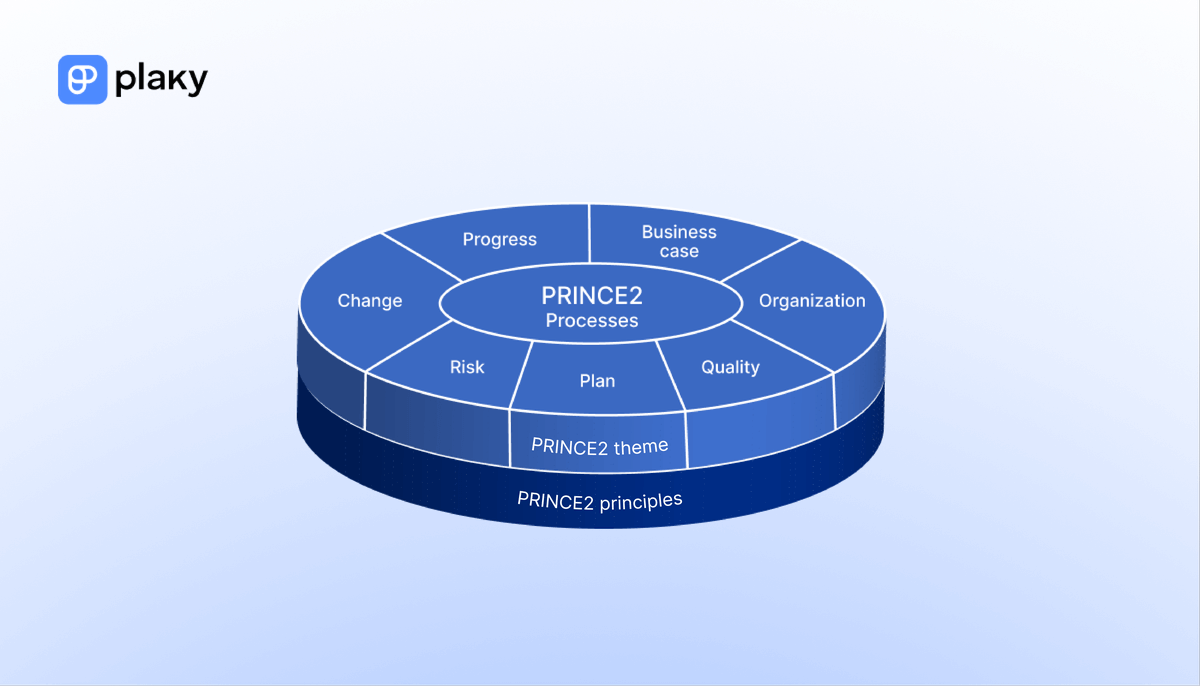
Benefits of PRINCE2 project management
As outlined in AXELOS’s white paper PRINCE2 in 1000 Words by Andy Murray, some of the PRINCE2 advantages are that it:
- Applies to any type of project,
- Easily integrates with industry-specific models,
- Saves valuable senior management time with its manage by exception principle,
- Makes sure that the project remains viable throughout the project life cycle, and
- Clearly specifies roles and responsibilities in a project so everyone knows what’s expected of them.
Furthermore, AXELOS’s Effective Project Management whitepaper outlines that PRINCE2 benefits individuals by:
- Providing step-by-step guidance regarding team structure, project planning, and project stages, and
- Providing an easy way to boost their resume.
In search of more PRINCE2 benefits examples, we consulted Pranav Radhakrishnan, Operations, Standards, and Strategy Director at a global pharmaceutical company, Novartis.
As an expert with the Six Sigma Black Belt and Lean Six Sigma Master Black Belt, Pranav believes that PRINCE2 facilitates the selection of innovative ideas that are in line with organizational goals and available resources:

“PRINCE2 captures the essence for analyzing various innovative ideas and approving them based on organizational goals and available resources… What PRINCE2 embodies at its core is that it encourages new ideas to come forth and rewards the best idea with approval.”
Pranav also highlights the benefit of PRINCE2 work packages (i.e. the set of information relevant to the creation of one or more products):

“In the modern day world, where teams are decentralized due to hybrid and remote work, PRINCE2 offers guardrails where a comprehensive plan is broken down into smaller work packages.”
PRINCE2 roles and responsibilities
As we’ve already mentioned, with PRINCE2’s clear organizational structure, there’s no confusion about who’s doing what at any time during the project.
Now, let’s take a closer look at each of the PRINCE2 roles and responsibilities.
Corporate, program management, or the customer appoints the executive and possibly the project manager. This body is responsible for:
- The provision of a project mandate (i.e. the trigger for the project),
- Governing the project, and
- Realizing any benefits that the project might deliver.
The project board is responsible for the project’s success and serves as a communication channel between the project team and external stakeholders. The project board is made up of:
- The executive — who is responsible for making ultimate decisions, and the development of a business case,
- Senior user(s) — who supports the executive by providing user resources, and
- Senior supplier(s) — who supports the executive by providing supplier resources.
Project assurance covers the primary stakeholder interests (business, user, and supplier). The role must be independent of the project manager.
Change authority is an optional role and is responsible for reviewing and approving or rejecting all change requests.
The project manager takes direction from the project board and the executive. They have the authority to run the project on a day-to-day basis and ensure that the project produces the desired results within the specified tolerances.
The team manager manages project team members and reports to the project manager.
Project support — sometimes referred to as the project management office (PMO) — serves as administrative support to the project team, e.g. in helping with project management software, guidance, and administrative services. Its formal implementation is optional, depending on the project size and environment.
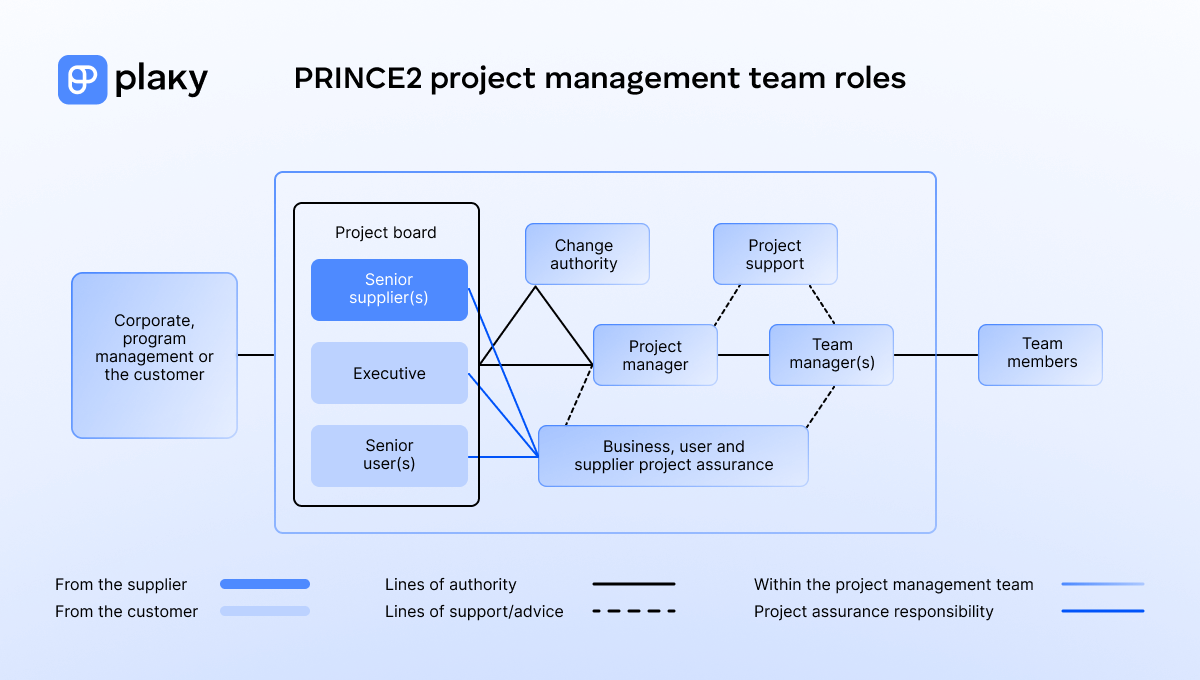
7 PRINCE2 principles
The PRINCE2 methodology is built on several universal principles that help PRINCE2 practitioners shape the project they’re managing.
Here are the 7 PRINCE2 project management principles as listed in Managing Successful Projects with PRINCE2:
- Continued business justification,
- Learn from experience,
- Defined roles and responsibilities,
- Manage by stages,
- Manage by exception,
- Focus on products, and
- Tailor to suit the project.
Let’s take a closer look at each of these principles.
Principle #1: Continued business justification
In PRINCE2, the first principle outlines there needs to be a justified reason for starting a project in the first place.
Also, the justification in some form of a business case needs to be recorded and approved. That justification should be reviewed repeatedly throughout the project.
Principle #2: Learn from experience
According to Managing Successful Projects with PRINCE2, learning should be a continuous process that happens in 3 phases:
- At the beginning of the project — by applying lessons from previous projects,
- During the project — by including lessons in relevant reports and reviews, and
- After the project closes — by passing on lessons for future projects.
Keep in mind that the lessons learned are the ones that drive change, otherwise, they remain merely the lessons identified.
Principle #3: Defined roles and responsibilities
A clear project management team structure is one of the prerequisites for project success.
This implies that all people involved in the project have defined roles and responsibilities and that there’s an effective communication flow among them.
Further, all stakeholder interests need to have a representation within the project management team, which includes the 3 primary stakeholders:
- Business sponsors — those who make sure there’s a justified business need,
- Users — those who will use the project’s output, and
- Suppliers — those who provide the necessary project resources to produce the project’s product.
Principle #4: Manage by stages
PRINCE2 projects are broken down into project sections called management stages.
The number of stages depends on the project’s complexity, but all projects must have at least 2 stages, including:
- An initiation stage, and
- At least one further management stage.
Managing by stages allows better control over the project’s progress.
Principle #5: Manage by exception
To understand this principle, we’ll first need to clarify the term exception in PRINCE2.
An exception is a situation that goes beyond the tolerance levels that the project manager and the project board have previously agreed upon, in terms of:
- Cost,
- Time,
- Quality,
- Scope,
- Benefits, and
- Risk.
So, if there’s no deviation from the previously agreed-upon tolerance levels, the project manager won’t need to notify the project board.
In cases of exceptions, one management level must immediately notify the next management level.
This practice helps establish clear management authorities and boundaries and prevents burdening senior management with lesser issues that would needlessly take up their time.
Principle #6: Focus on products
In PRINCE2, project outputs, or deliverables, are referred to as products, and the focus should be on the quality requirement of these products.
The focus on product principle has the following purposes:
- Ensuring that the project delivers only what’s been agreed upon,
- Preventing scope creep, and
- Reducing the risks of user dissatisfaction.
Principle #7: Tailor to suit the project environment
Being a universal project management approach, PRINCE2 aims at tailoring to fit each project’s specific needs based on the following factors:
- Project environment,
- Size,
- Complexity,
- Importance,
- Team capability, and
- Risk.
The tailoring principle allows PRINCE2 to be used in any project, regardless of its:
- Type,
- Geography, or
- Culture.
7 PRINCE2 themes
Themes in PRINCE2 represent the 7 aspects of project management that you should continually address throughout the project lifecycle.
All themes are interrelated, and each answers certain questions regarding the project:
| Theme | Questions the theme answers |
|---|---|
| Business case | Why? |
| Organization | Who? |
| Quality | What? |
| Plans | How? How much? When? |
| Risk | What if? |
| Change | What’s the impact? |
| Progress | Where are we now? Where are we going? Should we carry on? |
Now, let’s analyze each theme in more detail.
Theme #1: Business case
As explained in Managing Successful Projects with PRINCE2, a business case is an essential theme in a PRINCE2 project as it confirms whether a project is:
- Desirable,
- Viable, and
- Achievable
Developing the business case takes place at the beginning of the project and is documented in one of the following formats:
- A document,
- A spreadsheet,
- Presentations slides, or
- An entry in a project management tool.
A business case should answer the question of why you’re carrying out the project in the first place and justify the value of the money that’s being invested in the project.
Here are the basic components of a business case:
- Executive summary,
- Reasons for undertaking the project,
- Business options,
- Expected benefits,
- Expected dis-benefits,
- Timescale,
- Costs,
- Investment appraisal, and
- Major risks summary.
You should review and update the business case regularly throughout the project to ensure the investment remains worthwhile.
Theme #2: Organization
The organization theme aims to determine the project’s roles and responsibilities, as success often depends on effective communication.
To meet project stakeholders’ interests and ensure project success, a clear 4-level project management structure should be established:
- Corporate, program management, or the customer — that is external to the project team,
- Directing — the project board,
- Managing — the project manager, and
- Delivering — the team manager and team members.
Theme #3: Quality
The quality theme ensures that the project’s product:
- Meets business expectations, and
- Enables desired benefits realization.
To fulfill PRINCE2 quality requirements, a project needs to:
- Define the quality management approach, i.e. how you’ll manage the quality of the project,
- Specify quality criteria,
- Use a quality register to keep track of all quality activities,
- Specify the customer’s quality expectations and acceptance criteria, and
- Use lessons as a valuable source of information for analysis.
Theme #4: Plans
The plan theme serves to control the project and follow its progress.
In PRINCE2, there are 4 types of plans:
- Project plan — with key information on timescales, project milestones, cost, and resources,
- Stage plan — with management phases that make up the project lifecycle,
- Team plan — which is an optional plan used as the basis for team management control, and
- Exception plan — which replaces an existing project, or a stage plan.
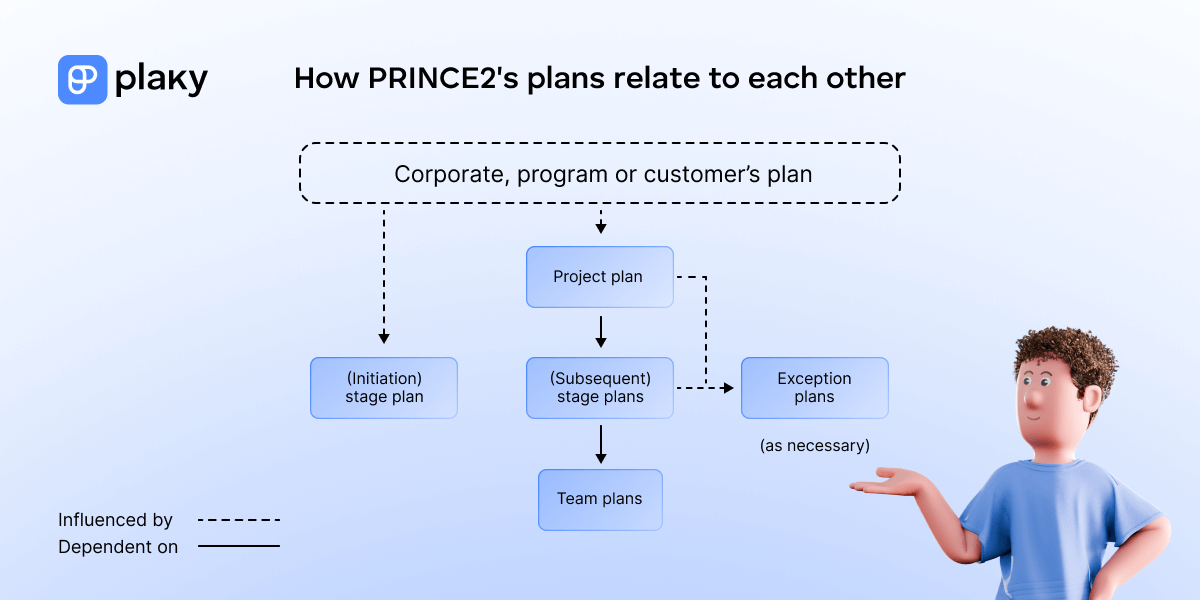
Theme #5: Risk
The risk theme aims to identify and control any uncertainties that may occur throughout a project.
In PRINCE2, there are 2 types of project risks:
- Threats — uncertain events that could have negative impacts, and
- Opportunities — uncertain events that could have positive impacts on project objectives.
To fulfill PRINCE2 risk management requirements, a project needs to:
- Define a risk management approach,
- Maintain some form of risk register,
- Have its risks identified and managed throughout the entire lifecycle, and
- Use lessons as a valuable source of information for analysis.
Theme #6: Change
Change deals with all potential and approved changes to the project baselines. In PRINCE2, all changes are called issues you need to:
- Identify,
- Assess, and
- Control.
To achieve this, you’ll need to have:
- Issue register, and
- Change control approach.
Theme #7: Progress
The progress theme aims to determine mechanisms for tracking progress against performance targets, including:
- Time,
- Cost,
- Quality,
- Scope,
- Benefits, and
- Risk.
Here are some techniques for progress evaluation, as listed in Managing Successful Projects with PRINCE2:
- Milestone chart — a visual representation of your milestones,
- S-curve — a graph showing cumulative project-related data,
- Earned value management — a project performance measuring technique,
- Burn charts — graphical representations of a project’s progress, and
- Kanban board — a signboard (physical or virtual) for tracking project progress.
Here’s an example of how you can track progress with the Kanban view, one of the Plaky project management tool features:
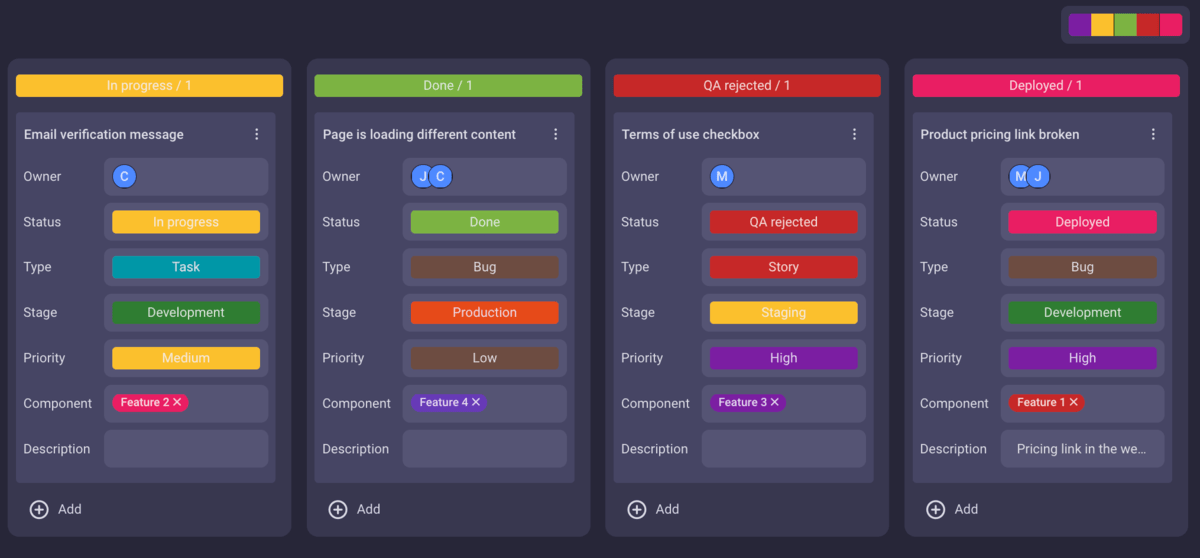
7 PRINCE2 processes
As the Managing Successful Projects with PRINCE2 guidebook defines them, processes are structured sets of activities designed to accomplish a specific objective.
In PRINCE2, there are 7 processes, including:
- Starting up a project,
- Directing a project,
- Initiating a project,
- Controlling a stage,
- Managing product delivery,
- Managing a stage boundary, and
- Closing a project.
Let’s analyze these processes in more detail.
Process #1: Starting up a project
According to Managing Successful Projects with PRINCE2, before making the final decision on whether the project is viable and worthwhile, there are certain activities you need to consider:
- Appoint the executive and the project manager,
- Capture previous lessons,
- Design and appoint the project management team,
- Prepare the outline business case,
- Select the project approach and assemble the project brief, and
- Plan the initiation stage.
Process #2: Directing a project
Directing a project process empowers the project board with the authority to make key decisions and control the project in general. On the other hand, day-to-day management of project activities is left to the project manager.
Within this process, the project board:
- Authorizes initiation,
- Authorizes the project,
- Authorizes a stage or exception plan,
- Gives ad hoc direction, and
- Authorizes project closure.
Process #3: Initiating a project
Establishing solid foundations for your project prevents spending considerable financial resources on a project that ends up being unsuccessful.
To fully understand the project, project managers should answer several questions such as:
- What the reasons are for doing this project,
- What the expected benefits are,
- What the risks are,
- How, when, and at what cost they will deliver the project,
- Who makes key decisions about the project,
- How they will control and monitor the project, and
- Who needs to be informed on all project information.
During this process, a project manager conducts several activities, such as to:
- Agree on the tailoring requirements,
- Prepare the risk management approach,
- Prepare the change control approach,
- Prepare the quality management approach,
- Prepare the communication management approach,
- Set up the project controls,
- Create the project plan,
- Refine the business case, and
- Assemble the project initiation documentation.
Process #4: Controlling a stage
As the name already suggests, the purpose of controlling a stage process is to ensure that the work to be done (also called work packages) is assigned and kept under control.
To be more precise, project managers conduct the following activities:
- Authorizing and reviewing work packages,
- Monitoring and reporting the management stage status and highlights, and
- Assessing and managing issues and risks.
After all, the day-to-day control of the work being done is key to a successful project.
Process #5: Managing product delivery
While controlling a stage process views the project from the project manager’s perspective, managing the product delivery process views it from the team manager’s perspective.
Team managers conduct the following activities within the managing product delivery process:
- Accept a work package — by clarifying what is to be delivered,
- Execute a work package — by following authorized requirements, and
- Deliver a work package — by notifying the project manager of its completion.
Process #6: Managing a stage boundary
At the end of each management stage, project managers conduct the managing a stage boundary process activities, including:
- Planning the next management stage,
- Updating the project plan,
- Updating the business case,
- Reporting management stage end, and
- Producing an exception plan.
The purpose of this process is to provide the project board with enough information to:
- Review the success of the current management stage,
- Approve the next stage plan,
- Review the updated project plan, and
- Confirm if there’s a continued business justification and risk acceptability.
Process #7: Closing a project
During this process, project managers do the following activities:
- Prepare planned closure,
- Prepare premature closure if requested so,
- Hand over products,
- Evaluate the project, and
- Recommend project closure.
A clear end to a project implies that you’ve met the original goals and you can transfer the ownership of products to the customer.
To track all activities throughout a PRINCE2 project, you can use PRINCE2 project management software such as Plaky:
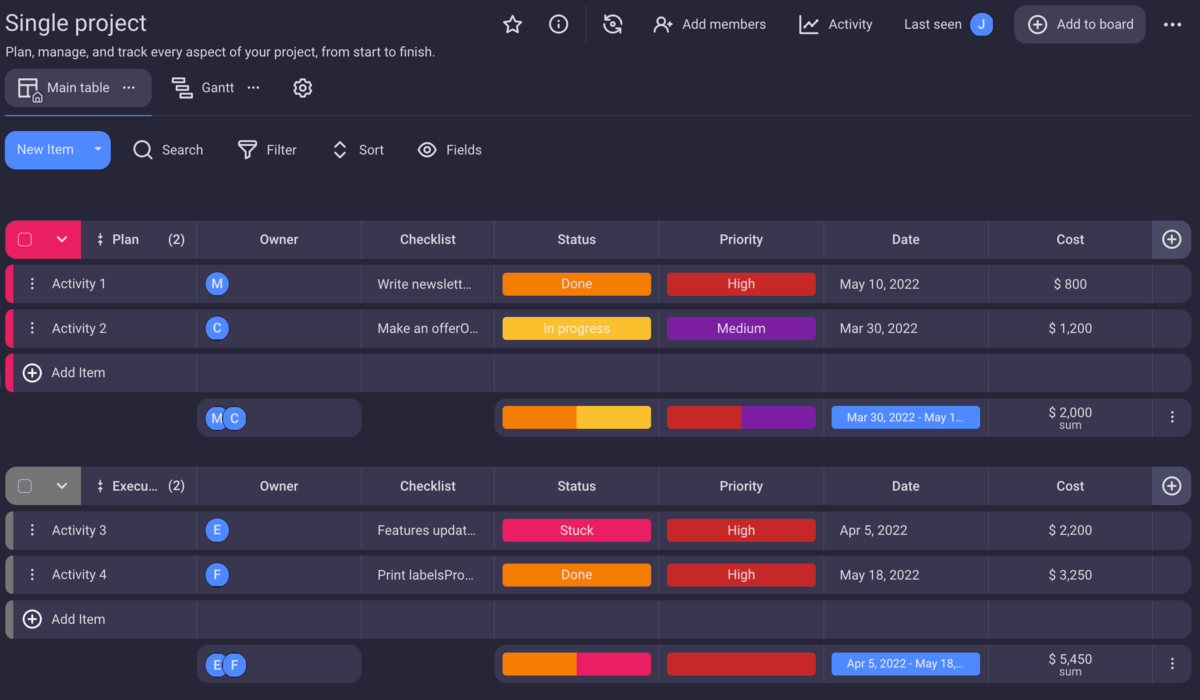
PRINCE2 certifications
At the moment, AXELOS offers PRINCE2 and PRINCE2 Agile certifications at 2 levels — Foundation and Practitioner:
- PRINCE2 Foundation,
- PRINCE2 Practitioner,
- PRINCE2 Agile Foundation, and
- PRINCE2 Agile Practitioner.
Foundation is suitable for beginners, while Practitioner is intended for advanced project practitioners.
If you decide to get PRINCE2-certified, you can choose the training style that suits you, as it comes in 3 formats:
- Self-studying, without attending an accredited training course,
- Online training, or
- Classroom training.
In case you opt for a training course, you should look for one of AXELOS’s Accredited Training Organizations in your country. Course prices will vary depending on the organization and certification type.
Starting from 2023, you’ll be able to renew PRINCE2 certifications after 3 years by:
- Re-taking your original exam,
- Taking further courses and certifications, or
- Through collecting and logging CPD (Continuous Professional Development) points.
PRINCE2 Foundation
PRINCE2 Foundation certification confirms that you possess theoretical knowledge on how to plan, manage, and deliver projects. Also, it confirms that you can work in a project management team in a PRINCE2 environment.
PRINCE2 Foundation is suitable for those who already work on PRINCE2 projects. But, it’s also great for those at the onset of their project management careers, as PRINCE2 Foundation doesn’t require previous experience in project management.
As for the exam format, the PRINCE2 Foundation exam is a 60-minute exam with 60 multiple-choice questions.
PRINCE2 Practitioner
The PRINCE2 Practitioner qualification is intended for anyone who manages projects on a day-to-day basis. It confirms that you can apply PRINCE2 and tailor it to suit various project environments.
As outlined in AXELOS’s PRINCE2 Prerequisites guide, to be eligible to take the PRINCE2 Practitioner exam, you need one of the following project management certifications:
- PRINCE2 (Foundation),
- Project Management Qualification (PMQ),
- Project Professional Qualification (PPQ),
- Project Management Professional (PMP),
- Certified Associate in Project Management (CAPM),
- IPMA Level A, B, C, or D.
The PRINCE2 Practitioner is a 150-minute long exam. As it’s an open-book exam, candidates are allowed to use the official printed hard copy of the Managing Successful Projects with PRINCE2® 2017 Edition during the exam.
PRINCE2 Agile Foundation
The PRINCE2 Agile Foundation certificate is intended for project management professionals working on agile projects. It helps them tailor PRINCE2 to suit agile project management concepts, such as:
PRINCE2 Agile Foundation has no prerequisites, so you can attend the course and exam even if you have no pre-existing knowledge of PRINCE2.
The exam is a 1-hour-long multiple-choice paper with 50 questions.
PRINCE2 Agile Practitioner
With PRINCE2 Practitioner, you’ll apply the knowledge acquired at the Agile Foundation level to the workplace, using real-world management examples.
However, to take the PRINCE2 Agile Practitioner examination, you need one of the following certifications:
- PRINCE2 Agile Foundation,
- Any PRINCE2 certification.
- Project Management Professional (PMP),
- Certified Associate in Project Management (CAPM), or
- IMPA Levels A, B, C, or D.
The exam lasts for 2.5 hours, and it’s open book, which means candidates are allowed to use the official printed hard copy of PRINCE2 Agile.
PMP vs PRINCE2 — which is better?
While the PRINCE2 certification is a registered mark of AXELOS, the PMP certification is PMI’s trademark.
PMBOK Guide is a fundamental resource for the PMP certification, while Managing Successful Projects with PRINCE2 and PRINCE2 Agile are original guidance books for PRINCE2.
According to the latest project management statistics, most project managers have the PRINCE2 certification, possibly due to the PRINCE2 test having a national average pass rate of 97% in the UK.
PMI, on the other hand, hasn’t published any official exam pass rates or passing scores since 2005, when the exam pass rate was 61%.
Allegedly, almost 2 million people have earned their PRINCE2 certifications to this day. PMI, on the other hand, reports there are more than 1,200,000 PMP certification holders worldwide.
PMP is objectively more difficult to get, as, unlike PRINCE2, it requires you to already have:
- A 4-year degree along with 3 years of experience and 35 hours of PM training, or
- A secondary education diploma along with 5 years of experience and 35 hours of PM education.
While both certifications are well-respected in the project management community, PRINCE2 and PMP aren’t equivalent.
PMP is harder to acquire, and can’t be owned without having years of documented experience in project management.
Here’s the summary of PMP and PRINCE2 differences:
| PRINCE2 | PMP | |
|---|---|---|
| Accreditation | AXELOS | PMI |
| Requirements | – PRINCE2 Foundation: None – PRINCE2 Practitioner: PRINCE2 Foundation, or other relevant certifications | – 4-year degree + 3 years of experience + 35h of PM training, or – secondary education diploma + 5 years of experience + 35h of PM education |
| Official guidebook | Managing Successful Projects with PRINCE2 | PMBOK Guide |
| Number of certification holders (approx.) | 2 million | 1,200,000 |
| Exam pass rate | – PRINCE2 Foundation: 97% in the UK – PRINCE2 Practitioner: 73% in the UK | No official records |
Expert opinion on which is better – PMP or PRINCE2?
We’ve asked our contributor, Pranav, to share his opinion and tell us which is better, PMP or PRINCE2.
Pranav believes that the answer depends on the specific industry you’re in.

“A PMP or PRINCE2 certification should be chosen depending upon the individual’s industry to create value.”
Pranav elaborates through an example that PMP, in some cases, lacks agility:

“Let’s talk about PMP first, PMP has been widely accepted for some time now as the gold standard in project management. A manager with exposure to both Lean Six Sigma and PMP will quickly recognize that the PMP structure works well for capital-intensive commercial construction projects. When applied to a different facet of industries in services and operations, one might feel the methodology lacks agility.”
On the other hand, Pranav believes that PRINCE2 embodies the necessary agility:

“PRINCE2 certifications, which are now well recognized and growing quickly in acceptance, capture not just project management principles but also embody agility at the heart of it.”
Here’s Pranav’s explanation of how PRINCE2 is beneficial in specific industries, such as in the example of large pharmaceutical companies:

“Large pharmaceutical companies, which represent the top 5 in global revenue with many manufacturing plants, have been rolling out standardization programs to identify, track, resolve, and report issues locally and be monitored globally. This requires a unique global project management office to manage the rollout of such programs.
These programs are staggered across many years and across many geographies to reach many factories which manufacture many types of medicines. PRINCE2 is extremely well suited to project manage the rollout of such programs because of its work package and stage gate philosophies which enables it to deliver a unique set of outcomes for every factory with agility.”
PRINCE2 example — The University of Western Australia Library case study
As outlined in a case study regarding project management and cultural change, inadequate management of the majority of the Library’s projects resulted in poor project performance back in 2005.
It was mainly due to factors, such as:
- Poorly defined project scope,
- Lack of clear direction,
- Running out of resources while the implementation was due,
- Unplanned and ad hoc transfer of projects to the operational stage,
- Poor project reporting, and
- Lack of clarity about projects’ status.
To fix poor results, the management implemented the PRINCE2 project methodology and delivered training sessions to the Library staff.
Soon, the new PRINCE2 method implementation transformed the organization from the core and brought many positive outcomes, such as:
- Better project planning and implementation,
- Better resource allocation,
- A better understanding of project roles and responsibilities,
- Improved cooperation and cross-team collaboration, and
- Improved project reporting.
Many cultural changes came along with the PRINCE2 implementation, including the spread of awareness about:
- Breaking down the silos,
- Building trust,
- Encouraging flexibility, and
- Developing leadership skills.
As we can see, PRINCE2 can be effectively applied in various industries and projects. This flexibility and applicability make PRINCE2 such a popular method in all corners of the world.
Conclusion: All project managers should get acquainted with PRINCE2 basics
PRINCE2’s universality makes it a universal PM method for all project managers around the world.
So, regardless of where you are or the industry you’re in — ranging from the public sector and IT, all the way to the pharmaceutical industry — PRINCE2 speaks the language common to all projects.
Moreover, if you want to get PRINCE2 certified, it doesn’t matter if you’re an aspiring or an experienced project manager, as PRINCE2 offers 2 levels of certification suitable for both.
In the end, whether you opt for PRINCE2 or not, getting acquainted with its core principles and ideas can do nothing but good, as you’ll probably find at least something worth applying in your future projects.
📖 You think PRINCE2 is the methodology for you, but would still like to expand your knowledge on project management? Visit our Project Management Glossary of Terms and dive into basic and advanced project management terminology.
How we reviewed this post: Our writers & editors monitor the posts and update them when new information becomes available, to keep them fresh and relevant.

